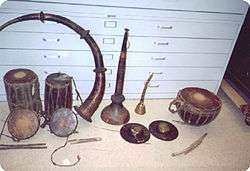Pancai baja

Panche baaja (Nepali: पञ्चे बाजा, "five musical instruments") is a set of five traditional Nepali musical instruments that are played during holy ceremonies,especially, marriages. Panche baajas are usually played by the Damai (Miji) and the Gaine; these are castes in the Hindu tradition.[1]
The first part of the term is also transliterated pance, panchai, or pancai; the latter also as baaja.
Components
The panche baja includes the jhyali (cybals), tyamko (small kettledrum) or dholak (drums), damaha (large kettledrum), narsiha (a long S-shaped trumpet), shehnai (a folk oboe), and karnal (a wide-mouthed, straight trumpet with a bell that resembles the datura flower.). http://yeahnepal.com/instruments-used-in-panche-baja/ Other rendering give the ensemble as: shehnai, jhyali, dholki, tyamko, and damaha.[2]
References
- ↑ Hao Huang (1999). Music in the 20th century. M.E. Sharp. p. 598. ISBN 978-0-7656-8012-9. Retrieved 24 March 2012.. In Nepal, musicians belong to two untouchable castes (groups of the lowest class in India, whom members of the four main castes were once forbidden to touch), the Damai and the Gaine. The ensembles are known as panche baja
- ↑ https://books.google.com/books?id=pW0wAQAAIAAJ&q=Panche+baja&dq=Panche+baja&hl=en&sa=X&ei=F_B2UfeAB4iL0QHYhYGwBA&ved=0CDUQ6AEwAA - Panche baja comprises Sanahai, Jhyali, Tyamko, Damaha and Dholaki. Damais (a particular caste) traditionally from ancient time have used Panche baja in marriage, festivals and local fairs joyfully